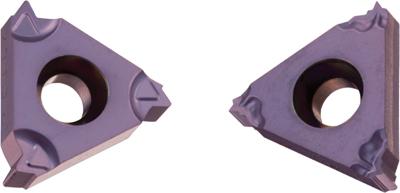
The latest addition to the Carmex Type B line includes a variety of 11mm inserts for internal thread turning and chamfering operations. Designed for Swiss-style and other precision machining operations, the inserts are engineered from BMA sub-micrograin grade (K20-K30, P20-P40) with advanced PVD coating for high wear and heat resistance in a wide range of materials and are available in most common thread profiles and thread pitch ranges.
Jeff Dei, President of Carmex USA, comments: "Our specially engineered profile is precision ground so as to provide the highest quality threads with superior finish, thanks to reduced cutting forces. The sintered chip-breaker improves chip control and flow, and the inserts are usable for most common materials. The new Type B line represents an example of Carmex's continuing commitment to its ever-growing line of tooling for Swiss-style machining. We see a wide variety of applications for these inserts in such areas as medical appliances and tools, communications equipment, aeronautics and defense, and others."
Contact Details
Related Glossary Terms
- chamfering
chamfering
Machining a bevel on a workpiece or tool; improves a tool’s entrance into the cut.
- physical vapor deposition ( PVD)
physical vapor deposition ( PVD)
Tool-coating process performed at low temperature (500° C), compared to chemical vapor deposition (1,000° C). Employs electric field to generate necessary heat for depositing coating on a tool’s surface. See CVD, chemical vapor deposition.
- pitch
pitch
1. On a saw blade, the number of teeth per inch. 2. In threading, the number of threads per inch.
- precision machining ( precision measurement)
precision machining ( precision measurement)
Machining and measuring to exacting standards. Four basic considerations are: dimensions, or geometrical characteristics such as lengths, angles and diameters of which the sizes are numerically specified; limits, or the maximum and minimum sizes permissible for a specified dimension; tolerances, or the total permissible variations in size; and allowances, or the prescribed differences in dimensions between mating parts.
- turning
turning
Workpiece is held in a chuck, mounted on a face plate or secured between centers and rotated while a cutting tool, normally a single-point tool, is fed into it along its periphery or across its end or face. Takes the form of straight turning (cutting along the periphery of the workpiece); taper turning (creating a taper); step turning (turning different-size diameters on the same work); chamfering (beveling an edge or shoulder); facing (cutting on an end); turning threads (usually external but can be internal); roughing (high-volume metal removal); and finishing (final light cuts). Performed on lathes, turning centers, chucking machines, automatic screw machines and similar machines.
